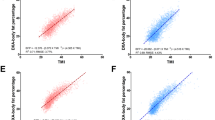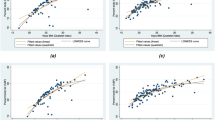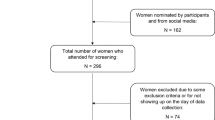Abstract
BACKGROUND: Obesity has been increasing dramatically in recent years among children, particularly African-American girls. Total-body electrical conductivity (TOBEC) is a simple way to measure body fat with minimal risk.
OBJECTIVE: This study compared the agreement between the percentage of fat mass (%FM) predicted using two TOBEC equations with %FM measured by a four-component model in 73 Caucasian and 41 African-American girls.
DESIGN AND MEASUREMENTS: %FM predicted using the TOBEC equations was compared with %FM from the four-component model based on measurements of body density, body water and bone mineral content.
RESULTS: Analyses by linear regression analysis and by the Bland and Altman methods comparison procedure showed that the equation using the square root of the TOBEC zero-order Fourier coefficient and the subject's height yielded more accurate and more reproducible %FM, regardless of race, than the TOBEC linear equation, which was based on the zero-, first- and second-order Fourier coefficients. The Bland and Altman comparison further revealed that the accuracy and limits of agreement of the TOBEC linear equation were related to body fatness among the Caucasian girls. The relationship, however, disappeared when prepubescent girls and a girl with low %FM were excluded from the analysis.
CONCLUSIONS: The TOBEC square root equation with adjustment for body geometry and length is recommended for use in adolescent girls, as it yielded better agreement with the criterion method. However, further validation of the TOBEC instrumentation for estimating body fat in prepubescent children and children with low body fat is warranted.
This is a preview of subscription content, access via your institution
Access options
Subscribe to this journal
Receive 12 print issues and online access
$259.00 per year
only $21.58 per issue
Buy this article
- Purchase on Springer Link
- Instant access to full article PDF
Prices may be subject to local taxes which are calculated during checkout




Similar content being viewed by others
References
de Bruin NC, van Velthoven KAM, Stijnen T, Juttmann RE, Degenhart HJ, Visser HKA . Quantitative assessment of infant body fat by anthropometry and total-body electrical conductivity Am J Clin Nutr 1995 61: 279–286.
de Bruin NC, Westerterp KR, Degenhart HJ, Visser HKA . Measurement of fat-free mass in infants Pediatr Res 1995 38: 411–417.
Presta E, Segal KR, Gutin B, Harrison GG, van Itallie TB . Comparison in man of total body electrical conductivity and lean body mass derived from body density: validation of a new body composition method Metabolism 1983 32: 524–527.
Horswill CA, Geeseman R, Boileau RA, Williams BT, Layman DK, Massey BH . Total-body electrical conductivity (TOBEC): relationship to estimates of muscle mass, fat-free mass, and lean body mass Am J Clin Nutr 1989 49: 593–598.
Lohman TG . Applicability of body composition techniques and constants for children and youths. In Pandolf KE (ed.) Exercise and sports sciences reviews Macmillan: New York 1986, pp 325–357.
Schutte JE, Townsend EJ, Hugg J, Shoup RF, Malina RM, Blomqvist CG . Density of lean body mass is greater in Blacks than in Whites J Appl Physiol 1984 56: 1647–1649.
Ortiz O, Russell M, Daley TL, Baumgartner RN, Waki M, Lichtman S, Wang J, Pierson RN Jr, Heymsfield SB . Differences in skeletal muscle and bone mineral mass between black and white females and their relevance to estimates of body composition Am J Clin Nutr 1992 55: 8–13.
van Loan MD, Koehler LS . Use of total-body electrical conductivity for the assessment of body composition in middle-aged and elderly individuals Am J Clin Nutr 1990 51: 548–552.
van Loan MD . Assessment of fat-free mass in teen-agers: use of TOBEC methodology Am J Clin Nutr 1990 52: 586–590.
Gortmaker SL, Dietz WH, Sobol AM, Wehler CA . Increasing pediatric obesity in the United States Am J Dis Child 1987 141: 535–540.
Troiano RP, Flegal KM, Kuczmarski RJ, Campbell SM, Johnson CL . Overweight prevalence and trends for children and adolescents Arch Pediatr Adolesc Med 1995 149: 1085–1091.
Tanner JM, Whitehouse RH . Variations of growth and development at puberty. In Atlas of children's growth, normal variation and growth disorders Academic Press: New York 1982, pp 122–127.
Boileau RA, Lohman TG, Slaughter MH . Exercise and body composition of children and youth Scand J Sports Sci 1985 7: 17–27.
Siri WE . Body composition from fluid spaces and density: analysis of methods. In Brozek J, Hanschel A (eds) Techniques for measuring body composition National Academy of Science: Washington, DC 1961, pp 223–244.
Akers R, Buskirk ER . An underwater weighing system utilizing ‘force cube’ transducers J Appl Physiol 1969 26: 649–652.
Wilmore JH . A simplified method for determination of residual lung volumes J Appl Physiol 1969 27: 96–100.
Wong WW, Lee LS, Klein PD . Deuterium and oxygen-18 measurements on microliter samples of urine, plasma, saliva, and human milk Am J Clin Nutr 1987 45: 905–913.
Bland JM, Altman DG . Statistical methods for assessing agreement between two methods of clinical measurement Lancet 1986 i: 307–310.
Glantz SA . The special case of two groups: the t-test. In Laufer RS, Geno TK (eds) Primer of biostatistics McGraw-Hill: New York 1981, pp 63–93.
Lohman TG . Basic concepts in body composition assessment. In Advances in body composition assessment Human Kinetics: Champaign, IL 1992, pp 1–5.
Lohman TG . Prediction equations and skinfolds, bioelectric impedance, and body mass index. In Advances in body composition assessment Human Kinetics: Champaign, IL 1992, pp 37–56.
Fiorotto ML, Cochran WJ, Funk RC, Sheng H-P, Klish WJ . Total body electrical conductivity measurements: effects of body composition and geometry Am J Physiol 1987 21: R794–R800.
Acknowledgements
The authors are indebted to the volunteers; to the staff of the Metabolic Research Unit at the Children's Nutrition Research Center, for meeting the needs of the subjects during the study; to Drs A Hergenroeder and R Hill for performing the physical examination to determine Tanner stages of sexual maturity; to Dr J Hoyle in the Pediatrics Department of Kelsey-Seybold West Clinic, Dr M desVignes-Kendrick, director of the City of Houston Health and Human Services Department, Ms X Earlie, director of sciences of the Aldine Independent School District, Ms S Wooten, principal of the Teague Middle School, Dr B Shargey, dean of instruction, Ms CC Collins, principal at the High School for Health Professions and Ms K Wallace for subject recruitment; Mr M Puyau and Mr FA Vohra, for the underwater weighing measurements; Mr R Shypailo and Ms J Joe for the dual-energy X-ray absorptiometry measurements; Mrs L Clarke, Mr S Zhang and Ms K Usuki for the isotope ratio mass spectrometric measurements; and Ms L Loddeke, for editorial assistance in the preparation of the manuscript. This work was funded in part with federal funds from the US Department of Agriculture (USDA)/Agricultural Research Service under Cooperative Agreement no 58-6250-6-001.
Author information
Authors and Affiliations
Corresponding author
Additional information
Disclaimer: The contents of this publication do not necessarily reflect the views or policies of the USDA, nor does mention of trade names, commercial products, or organizations imply endorsement by the US Government.
Rights and permissions
About this article
Cite this article
Wong, W., Stuff, J., Butte, N. et al. Estimation of body fat in Caucasian and African-American girls: total-body electrical conductivity methodology versus a four-component model. Int J Obes 24, 1200–1206 (2000). https://doi.org/10.1038/sj.ijo.0801369
Received:
Revised:
Accepted:
Published:
Issue Date:
DOI: https://doi.org/10.1038/sj.ijo.0801369
Keywords
This article is cited by
-
Body Composition of African American and White Children: A 2-Year Follow-Up of the BAROC Study
Obesity Research (2001)



